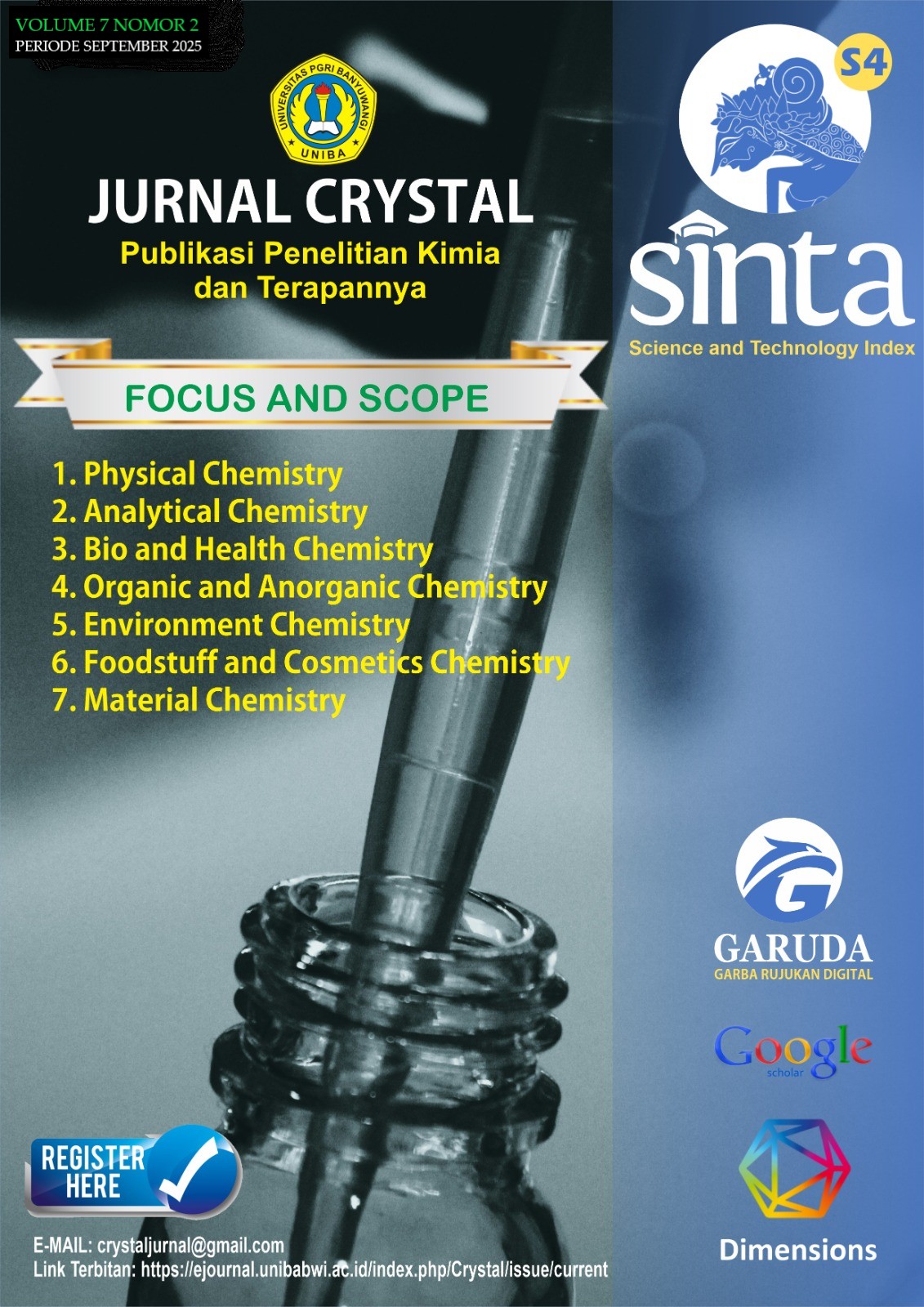OPTIMIZATION OF VALUABLE MINERALS (MG2+ & K⁺) RECOVERY FROM SEAWATER USING RESPONSE SURFACE METHODOLOGY (RSM)
DOI:
https://doi.org/10.36526/jc.v7i2.6284Keywords:
Co-precipitation, Response Surface Methodology (RSM), SeawaterAbstract
The extraction of metallic ions from seawater brine within a circular economy framework presents economic promise yet is hampered by concomitant ionic interference manifested during the precipitation of salts. The present investigation sought to characterize and subsequently to refine the co-precipitation steps for magnesium and potassium ions such that they yield suitable precursors for the synthesis of struvite fertilizer. The experimental work utilized a Response Surface Methodology built upon a Face-Centered Central Composite Design, interrogating the influence of the molar ratio of sodium hydrogen phosphate to calcium chloride and the duration of reaction on the simultaneous recovery of Mg²⁺ and K⁺. Results from the Analysis of Variance demonstrated that the principal effects of the aforementioned ratio, reaction duration, and their interaction terms were statistically significant for both target recoveries. By iterative optimization, the experimental framework predicted optimal operational parameters of sodium hydrogen phosphate to calcium chloride ratio of 0.401 and a reaction interval of 11.608 minutes, corresponding to a composite desirability statistic of 0.908 and estimated recoveries of 93.979 % and 97.300 % for magnesium and potassium ions, respectively. The data therefore substantiate the conclusion that Response Surface Methodology provides a systematic and analytically tractable conduit for the resolution of equilibrated brine mixtures, delineating a refined process envelope that promotes the extraction and economic valorization of essential mineral fertilizers from industrial saline streams.
References
Alam, P., Noman, O. M., Herqash, R. N., Almarfadi, O. M., Akhtar, A., & Alqahtani, A. S. (2022). Response Surface Methodology (RSM)-Based Optimization of Ultrasound-Assisted Extraction of Sennoside A, Sennoside B, Aloe-Emodin, Emodin, and Chrysophanol from Senna alexandrina (Aerial Parts): HPLC-UV and Antioxidant Analysis. Molecules 2022, Vol. 27, Page 298, 27(1), 298. https://doi.org/10.3390/MOLECULES27010298
Le Corre, K. S., Valsami-Jones, E., Hobbs, P., & Parsons, S. A. (2009). Phosphorus Recovery from Wastewater by Struvite Crystallization: A Review. Critical Reviews in Environmental Science and Technology, 39(6), 433–477. https://doi.org/10.1080/10643380701640573
Lee, J. J., & Yoon, K. Y. (2021). Optimization of ultrasound-assisted extraction of phenolic compounds from bitter melon (Momordica charantia) using response surface methodology. CyTA - Journal of Food, 19(1), 721–728. https://doi.org/10.1080/19476337.2021.1973110
Loganathan, P., Naidu, G., & Vigneswaran, S. (2017). Mining valuable minerals from seawater: a critical review. Environmental Science: Water Research & Technology, 3(1), 37–53. https://doi.org/10.1039/C6EW00268D
MOHAMMED, J., SANI, A., & OLANREWAJU, B. (2025). RESPONSE SURFACE METHODOLOGY (RSM): A COMPUTATIONAL APPROACH FOR OPTIMIZATION OF BIODIESEL PRODUCTION PARAMETERS FROM DIFFERENT FEEDSTOCKS. International Journal of Modeling and Applied Science Research. https://doi.org/10.70382/caijmasr.v8i9.027
Montgomery, D. C. . (2017). Design and analysis of experiments. John Wiley & Sons, Inc.
Pujiastuti, C., Sumada, K., Ngatilah, Y., & Hadi, P. (n.d.). REMOVAL OF Mg 2+ , K + , SO4-2 IONS FROM SEAWATER BY PRECIPITATION METHOD. https://doi.org/10.1051/conf/2016
Raziani, A., & Mohammadidoust, A. (2020). Modeling and optimization study by response surface methodology on magnesium ions removal from hard water through a biosorbent. In Journal of Applied Research in Water and Wastewater (Vol. 13, Issue 1).
Uysal, S., Cvetanović, A., Zengin, G., Zeković, Z., Mahomoodally, M. F., & Bera, O. (2019). Optimization of Maceration Conditions for Improving the Extraction of Phenolic Compounds and Antioxidant Effects of Momordica Charantia L. Leaves Through Response Surface Methodology (RSM) and Artificial Neural Networks (ANNs). Analytical Letters, 52(13), 2150–2163. https://doi.org/10.1080/00032719.2019.1599007
Variyana, Y., Fitria, M., Muchammad, R. S. C., & Mahfud, M. (2024). Enhancing Indian onion (Allium Cepa L. var. aggregatum) extraction by microwave hydrodiffusion and gravity (MHG) method: Parametric study and optimization using FCCD design. Results in Engineering, 24. https://doi.org/10.1016/j.rineng.2024.103294
Wei, L., Tang, Y., Zhang, T., Ji, J., Zhang, Q., Dong, Y., Luo, L., Ding, X., & kong, J. (2025). Factors influencing K-struvite purity via phosphorus coprecipitation in synthetic urine: Verification, quantification, and modelling. Environmental Research, 264, 120346. https://doi.org/10.1016/J.ENVRES.2024.120346
Zaid, H., Al-Sharify, Z. T., Hamzah, M. H., & Rushdi, S. (2022). OPTIMIZATION OF DIFFERENT CHEMICAL PROCESSES USING RESPONSE SURFACE METHODOLOGY-A REVIEW. Journal of Engineering and Sustainable Development, 26(6), 1–13. https://doi.org/10.31272/jeasd.26.6.1
Zhang, X., Zhao, W., Zhang, Y., & Jegatheesan, V. (2021). A review of resource recovery from seawater desalination brine. Reviews in Environmental Science and Biotechnology, 20(2), 333–361. https://doi.org/10.1007/S11157-021-09570-4/METRICS
Downloads
Published
How to Cite
Issue
Section
License
Copyright (c) 2025 Raka Selaksa Charisma Muchammad, Aisyah Alifatul Zahidah Rohmah, Caecilia Pudjiastuti, Alifah Nur Aini Fajrin, Ketut Sumada

This work is licensed under a Creative Commons Attribution 4.0 International License.















